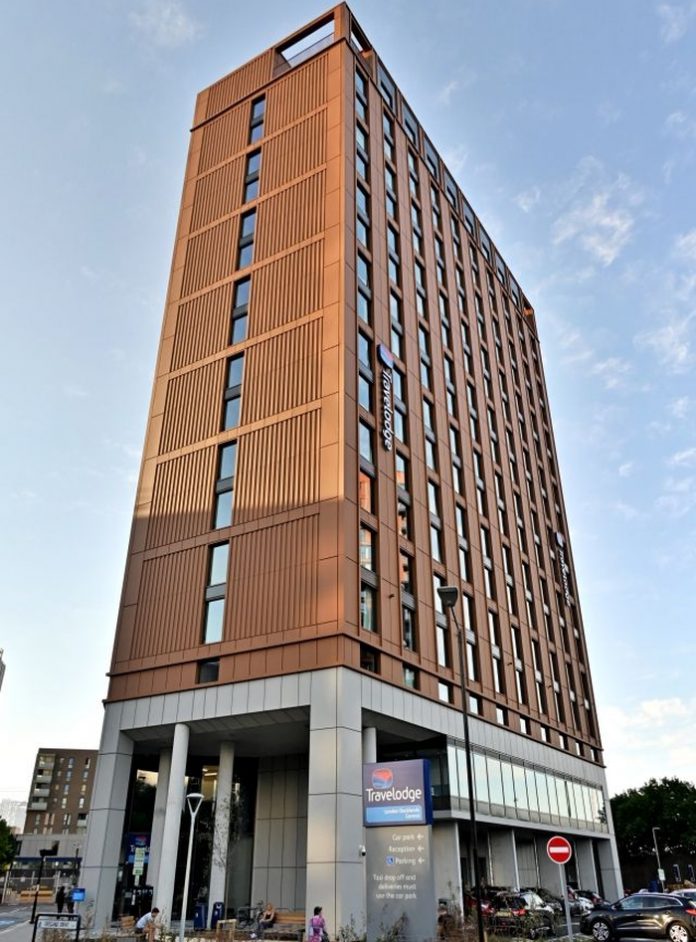Hospitality design expert, Dexter Moren Associates (DMA), is celebrating the completion of a new-build 18-storey, 350-room Travelodge hotel in the East India Dock area of London Docklands. The hotel development by Tarragon Development Limited is a joint venture between and Marick Real Estate and Mill Lane Estates and has been designed by DMA to reflect the industrial history of the site and its surrounding architecture.
The new London Docklands Travelodge hotel is the company’s first new-build premium look and feel budget luxe hotel design. This new design has been created on the success of the group’s budget chic hotel format, ‘TravelodgePLUS’ with feedback from the company’s largest consumer study – which surveyed around 5,000 UK business and leisure travellers to find the psychographics of the modern budget traveller. Key findings revealed that modern travellers crave style, choice and little homely touches to make it easier to work, rest and relax both inside and outside of the room.
The London Docklands Travelodge hotel features an on-site restaurant, a car park and a range of family, double and accessible budget-luxe and SuperRooms. Rooms offer scenic views of the O2, The Thames and Canary Wharf. This is also the most sustainable Travelodge hotel with a BREEAM Excellent rating, an Energy Performance Certificate rating of A and a number of sustainable features which includes solar panels on the roof, air source heat pumps and electric vehicle charging points.
Tarragon Development’s Executive Chairman, Andrew White, commented: “DMA has been singularly responsible in ensuring that the hotel was delivered to the exacting standards and quality, which is there for all to witness today. But for DMA and the team working seamlessly together with the main contractor John Sisk & Sons and the supply chain, this hotel would not have been completed five months early. The DMA team undoubtedly make things happen!”
Sustainability and carbon reduction have been one of the key drivers of DMA’s design. The scheme offers an active and inclusive enhanced public realm, delivering a net-gain in the ecological value of the site, post construction, owing to the higher distinctiveness and biodiversity value of the proposed habitats, rather than the species-poor habitats on the existing site
As Mark Wood, Partner at DMA, explains: “Our design addresses the diminishing heritage in this area of London Docklands, responding to the site’s original use as a dock, now back-filled. Metal crane structures, boat construction, dock walls and local architecture all influenced the design development. The choice of a tower responds to the immediate Docklands context, with a tripartite form and restrained palette in terms of its materials, details, texture and colour.”
The articulation and materiality of the base provides a simple grounding whilst a giant concrete-effect beam and corner columns produce the impression that the weight of the tower is distributed to each corner of the podium. By contrast, the light, glazed restaurant element has the feeling that it is hanging from the structure above. The double-height entrance glazing, combined with the generous double-height entrance area, unambiguously defines the building’s main entrance.
The middle volume of the tower is articulated with materials evocative of giant steelwork sections reflecting the local industrial maritime history. The material palette for the top floors of the building is metal and glass, creating variety through differing colours and textures. The top floor crowns the building with an elegant composition of narrowing folded aluminium cladding and increased grey perforated metal infill.
Laurynas Deveikis, Senior Project Architect, says: “This was an exceptionally challenging project, with a tight planning and construction programme. Despite the construction starting at the peak of the pandemic, and with material shortages, the project was delivered in advance of the projected completion date.
On a constrained site with the East India Dock Road tunnel running centrally beneath the site and surrounding vicinity previously consisted of disused, private and industrial land, our carefully conceived scheme now provides quality new guest accommodation and facilities, as well as a safer, more active and public urban environment.”
Achieving a BREEAM ‘Excellent’ rating, the hotel features a biodiverse brown roof, air source heat pumps, solar PV arrays as well as a pocket park at the grand entrance area, providing amenity space for the public, hotel staff and hotel guests. An attractive pedestrian walkway enhances the existing public realm located along the cycle super highway which borders the site. A 1100sq m green hedge buffer and a corner park contains a selection of native species, as well as a memorial for the former dock wall.
The Travelodge budget-luxe design also includes a number of sustainable initiatives, such as carpet made from recycled fishing nets as part of a project to support clean ocean initiatives. The carpet backing is also made of old plastic bottles. Other features include low energy lighting, motion sensing controls and aerated showers and taps.
Tarragon Development’s Executive Chairman, Andrew White, concludes: “From inception to completion, DMA have been exceptional, in relation to their attitude, approach and culture, the very ethos that we instilled in each and every member of the delivery team. They could not have done any more, with regards to their, passion, focus, determination, commitment and flexibility. I now look forward to working with them again.”






















